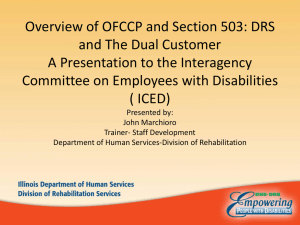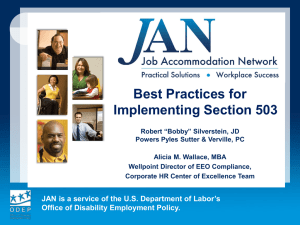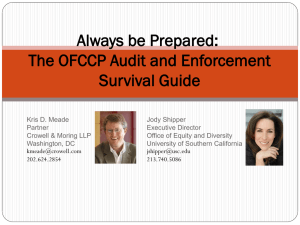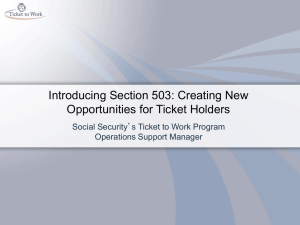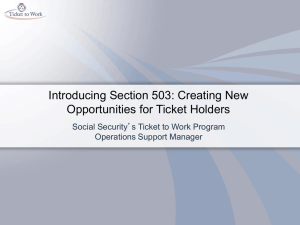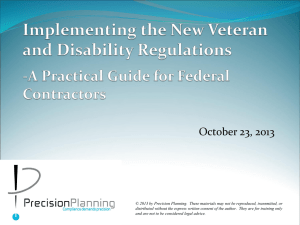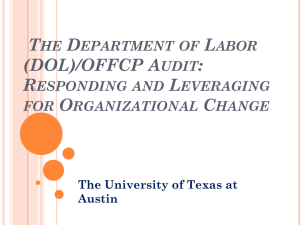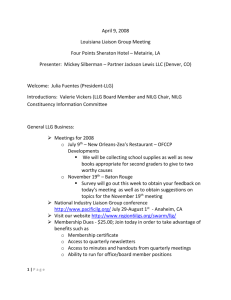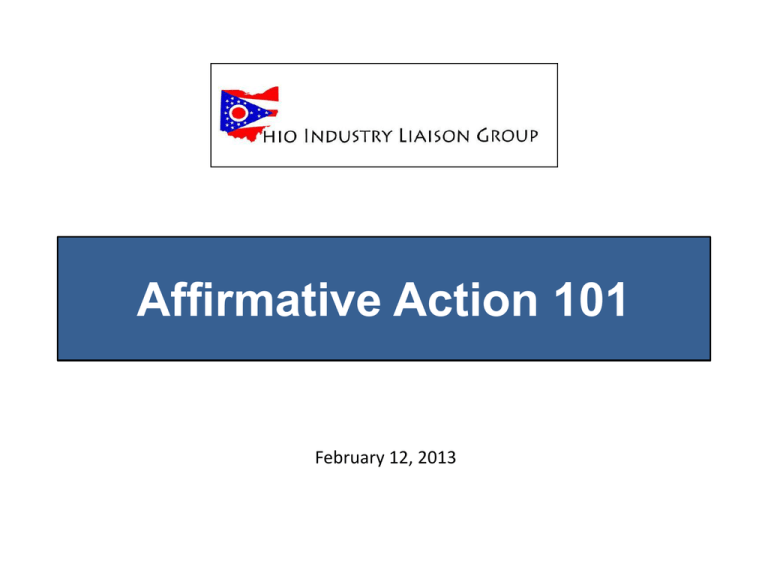
Affirmative Action 101
February 12, 2013
What is Affirmative Action?
A set of focused procedures and good faith efforts, which
an employer carries out to ensure that equal employment
opportunities are provided for all employees and
applicants.
What is an Affirmative Action Plan?
There are two types of Affirmative Action Plans (AAPs)
•
•
AAP for Veterans and Individuals with Disabilities
AAP for Minorities and Women
The AAP for Veterans and Individuals with Disabilities
contains only narrative information while the AAP for
Minorities and Women contains detailed workforce
analysis, tables and reports in addition to a narrative.
How do the types of AAPs differ?
• Women & Minorities
– Statistical analyses
– Percentage placement rate goals
– Narrative components
• Individuals with Disabilities/Covered Veterans
– Narrative elements only
– Focus on outreach, accommodation & removing barriers to
employment
Who needs to have an Affirmative Action Plan?
Employers are required to establish written AAPs for
females and minorities and for veterans and individuals
with disabilities if they have 50 or more employees and
meet one of the following four criteria:
1. Have at least one single government contract for $50,000 or
more in any 12-month period
2. Have government bills of lading totaling $50,000 or more in any
12-month period
3. Serve as a depository of Government funds in any amount, or
4. Are a financial institution which is an issuing and payment agent
for the US savings bonds and savings notes in any amount
What needs to be done in order to comply?
• Track
and analyze employment data, including hires, promotions, terminations
and applicant flow
• Compensation
analysis
• Training
• Equal
employment opportunity recruiting of qualified individuals
• Post
positions with state workforce agencies
• Post
required federal and state posters
• Record
retention
– Including employment records that can demonstrate that all decisions were based
on legitimate, non-discriminatory reasons
– Recordkeeping violations are historically the most frequent OFCCP citations
– OFCCP has the right to presume that information not available or not properly
maintained would have been unfavorable to the contractor
Do all facilities need to have an AAP?
• Each facility may not need its own AAP, but every single employee
needs to be included in an AAP
• If there are fewer than 50 employees at a particular establishment, the
contractor may:
– Develop an AAP including only the workforce at the establishment
– Include those employees in the AAP that covers the location of the human
resources function which supports that facility
– Include those employees in the AAP that covers the location of the official to whom
those employees report
• Some contractors also develop FAAP’s
– Based on business units of multi-establishment companies rather than by facility
– Prior approval must be received by the Deputy Assistant Secretary for the OFCCP
Objectives of an AAP
•
Attempting to remove imbalances between availability
and the incumbency of women and minorities
• Equal opportunities, not preferences
• Commitment of good faith efforts
• Commitment to review practices, monitor performance
and correct problems
Components of an AAP
• Organizational Profile (Workforce Analysis)
• Job Group Analysis
• Placement of incumbent employees in job groups
• Determination of the availability of qualified women
and minorities in the relevant labor market
• Analysis comparing employee incumbency to
availability
• Placement goals for any underutilized groups
What is Adverse Impact?
• Adverse impact is a significant difference in the
selection rates of one group compared with another
group
• Selections encompass hires, promotions and
terminations
• Groups for comparisons include:
– Men vs. women
– Minorities vs. non-minorities
– Must include individual race/ethnic groups for each
group that makes up 2% or more of population
How is Adverse Impact measured?
• The Hiring Adverse Impact analysis compares the
applicant pool vs. those selected for the positions
– Adverse Impact in Hiring means that over a period of time,
women and/or minorities, or a particular minority group,
were not hired in proportion to their representation in the
candidate pool
• For Promotions and Terminations, you need to
compare workforce demographics as of the start of the
previous plan year vs. the employees who were
promoted or left the company during the year
How is Adverse Impact measured?
• Two common tests
– 80% rule of thumb
– Statistical significance
• “Test of the two proportions” for larger groups
• Fisher’s exact test for small groups
• Other professionally accepted tests may be used
• The 80% rule of thumb is a commonly used test, but
it has its flaws
• Statistical significance is the true test
Action Oriented Programs
• Should be tailored to remedy specific concerns
• Should cite the type and frequency of action
• Should include monitoring and evaluation process used
to determine success
– Develop and execute action oriented programs designed
to correct problems areas
– Must annually evaluate effectiveness to ensure results are
achieved; if not, new efforts must be taken
– Must demonstrate good faith efforts
What are EEO Categories and Job Groups?
• In order to regulate job titles included in your organization as required by the
regulations, all contractors are required to group their job titles into subsets
called ‘EEO job categories’
• Groupings represent broad categories into which all jobs at your location fall
based on skill, job function and wages
• Traditionally, these broad categories are identified as follows:
1 - Officials & Managers
1.1 - Executive/Senior Level
1.2 - First/Mid Level
2 - Professionals
3 - Technicians
4 - Sales Workers
5 - Office & Clerical
6 - Craft Workers
7 - Operatives
8 - Laborers
9 - Service Workers
What are EEO Categories and Job Groups?
•
•
•
•
•
•
•
•
•
1A2 – Vice Presidents
1A3 – Directors
1B4 – Managers
1B5 – Supervisors
2A – Admin. Profs.
2B – Financial Profs.
2C – Data Proc. Profs.
2D – Scientific Profs/
2E - Engineers
•
•
•
•
•
•
•
•
•
•
•
3A – General Technicians
3B – Computer Technicians
4 – Sales
5A – Office & Clerical - Salaried
5B –Office & Clerical - Hourly
6A – Craft Workers
6B – Leaders
7A – Operatives
7B – Truck Drivers
8 – Laborers
9 – Service Workers
Annual Affirmative Action Obligations
• 50 Employees & $50,000
• AAP Update
• Adverse Impact Analysis
- Applicants/Hires, Promotions, Terminations, Testing
- Component Analysis
• Compensation Analysis
• EEO-1 Report
• VETS 100
• Outreach, outreach, outreach
OFCCP Scheduling Letter
• Requests AAPs
-Executive Order 11246
- Section 503 of the Rehabilitation Act
- Vietnam Era Veterans’ Readjustment Assistance Act
• Requests Support Data
-Personnel Activity (Prior & Current Year)
- EEO-1 Reports (last 3 years)
- Compensation Data (current snapshot)
- Past and present goals
OFCCP Audit Process
• Compliance Evaluations
– Review contractors’ employment practices
• Examines whether contractor maintains nondiscriminatory hiring
and employment practices
• Examines whether contractor is taking affirmative action to ensure
applicants and employees have an equal employment opportunity
without regard to race, color, religion, sex, national origin, disability
or status as a protected veteran
• Also conducts Corporate Management Compliance Evaluations
– Review designed to determine whether qualified minorities,
women, persons with disabilities and protected veterans have
encountered artificial barriers to advancement into mid-level
and senior corporate management
OFCCP Audit Process
• Types of Compliance Evaluations
– Desk Audit
• Compliance Officer analyzes employment and demographic data
provided by the contractor
• Information is provided regarding hiring, promotion, and
termination actions, and the establishment’s compensation
practices
• Facility’s affirmative action efforts are also examined
• If there are no indications of possible violations, the compliance
evaluation may be closed at this state
OFCCP Audit Process
• Types of Compliance Evaluations
– On-site Investigation
• If the investigation is not closed at the Desk Audit stage, an on-site
investigation will be scheduled and conducted
– OFCCP may request additional information related to any
issues they found during the Desk Audit stage
– OFCCP will most likely request to to speak with company
officials or staff
– Complaint Investigations
• OFCCP also conducts investigations of complaints of
discrimination that are filed by applicants or employees against
Federal Contractors
• OFCCP works in coordination with the EEO when processing
discrimination complaints
OFCCP Audit Process
• Types of Compliance Evaluations
– On-site Investigation
• If the audit is not closed at the Desk Audit stage, an on-site
investigation will be scheduled and conducted
– OFCCP may request additional information related to any
issues they found during the Desk Audit stage
– OFCCP will most likely request to speak with company
officials or staff
– Complaint Investigations
• OFCCP also conducts investigations of complaints of
discrimination that are filed by applicants or employees against
Federal Contractors
• OFCCP works in coordination with the EEO when processing
discrimination complaints
Common Problems – OFCCP Audits
• Insufficient Applicant Flow
– Census Data
– Recordkeeping
• Outreach Efforts
– Listing jobs (Must post to all State Workforce Agencies, in the
manner in which each state requires)
– Recruitment efforts
– No tracking of efforts
– 59% of the violations in FY12 were related to outreach and
recruitment
• Internal Audit & Reporting (Self-Audit)
• Compensation disparities (Fix before you are audited)
What are potential penalties?
• Show Cause Notice
– 30 days to comply
– Enforcement Proceedings
– Not just more time to submit
•
Conciliation Agreement
– Outlines violations found related to nondiscrimination and equal
opportunity provisions
– Formal legal document
– Requires written remedies
– Reporting to OFCCP for a specific time period
Worst-Case Scenario
• Back pay
– Formula relief is calculated using a shortfall
• Shortfall (Expected minus Actual)
– Number in shortfall x value of position (mitigated)
• Interest is compounded quarterly
• Mandated Hires = number in the shortfall
• Retroactive seniority and benefits
OFCCP Audit Experience
• What are the most important things contractors can do
to ensure a successful outcome?
– Build a positive relationship with the Compliance
Officer (CO)
• Try to find something they might have in common
• Mention affiliation with an Industry Liaison Group
• Be pleasant in all discussions with the CO
– Notify everyone with a ‘need to know’ that an audit is
underway – including Direct Employers!
– Send AAP within the 30-day time period
Best Practices
• CEO and leadership support
• Annual Management meetings
• Accountability
• Safeguarding Data Integrity
– Awareness of changes in HRIS
– Employment Actions Match HRIS
• Frequent Monitoring of Employment Decisions & Follow Up
• Hands-On Relationships with Community Organizations
• Unbiased Internal Assessment (Mock Audit)
Final Thoughts…
• Bottom Line:
– The culture today with the OFCCP is more of a ‘we vs. them’ approach
– They have an expectation that they will find discrimination in one form
or another in each audit – in fact, they receive bonuses based on the
financial remedies they recover
– Audits can extend for an unlimited period of time so the CO can revisit
areas already discussed and agreed upon
– OFCCP is now acting as a true enforcement agency
– Contractors need to build relationships with their CO’s
– Remember, everyone should all have the same goal:
Proving that companies are not discriminating!
Q&A
Thank You!

